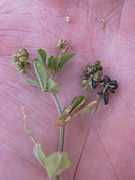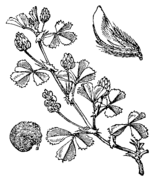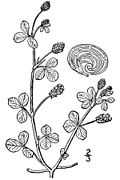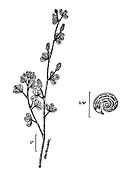Medicago lupulina
| Medicago lupulina | |
|---|---|
 | |
| Scientific classification | |
| Kingdom: | Plantae |
| (unranked): | Angiosperms |
| (unranked): | Eudicots |
| (unranked): | Rosids |
| Order: | Fabales |
| Family: | Fabaceae |
| Subfamily: | Faboideae |
| Tribe: | Trifolieae |
| Genus: | Medicago |
| Species: | M. lupulina |
| Binomial name | |
| Medicago lupulina L. | |
Medicago lupulina, commonly known as black medick or nonesuch, is a familiar lawn plant belonging to the legume or clover family. Like members of the trifolium genus (the "true clovers"), black medick has three leaflets and a small, yellow flower closely resembling those of white clover, and as such is sometimes considered a yellow clover. It belongs to the same genus as alfalfa, and is closely related to both the true clovers and sweet clover.[1]
Description
Medicago lupulina is an annual or biennial plant, often long-lived thanks to adventitious buds on the roots. Mature plants measure from fifteen to sixty centimeters in height, with fine stems often lying flat at the beginning of growth and later erecting. The nodes bear three leaflets, carried by a long petiole and have oval leaflets, partially toothed towards the tip. The center leaflet is on a separate petiole.
Black medick is easily recognized by its small yellow flowers, often grouped in tight bunches, and typically measuring between two and four millimeters in diameter, although larger plants can produce flowers nearing the size of white clover. The fruit is a small, ovoid pod, between one and two millimeters in length, that does not open upon maturation, and bears a single seed. Pods grow in bunches of varying size, and are green until ripening, when they harden and turn black.
Black medick has a tap root, and like other legumes, the roots feature nodules containing nitrogen-fixing bacteria.
Distribution
A native of the old world, black medick is found throughout Europe, north Africa, and much of Asia, including India, China, and Korea. It thrives in dry limestone grounds and coastal sand dunes, where it suffers less competition from the other plants, and as such is found on many islands, such as Taiwan, the Canary Islands, and Madeira. The plant is naturalized throughout the United States, including Hawaii. Black medick is resistant to cold, and can be found on mountains up to 1,800 meters.
Uses
A common sight in dry or well-drained lawns, where it may be considered a weed, black medick is one of the flowers used to make honey. It is frequently found in natural pastures, and may be planted in order to create artificial meadows, especially on dry land. The presence of black medick in large concentrations in a lawn may indicate that the soil is poor in nitrogen. However, because black medick and other clovers fix nitrogen in the soil, this deficiency can improve over time due to the presence of these plants.
Black medick is sometimes used as a fodder plant. Its hardiness and ability to grow in poor soils, as well as its tendency to fix nitrogen in the soil, make black medick a good choice for pasturage, although its fodder value is limited.
Similar plants
Black medick is sometimes considered a type of yellow clover, although the closely related true clovers belong to the genus trifolium. It is often confused with other plants that have three leaflets and small yellow flowers, such as hop trefoil, lesser hop trefoil, and yellow woodsorrel.
Synonyms
Black medick, sometimes spelled medic or meddick, is also known as nonesuch, and has a number of other common names, including black hay, black nonesuch, or blackweed.[2][3] Members of the medicago genus are sometimes called bur clovers.[1]
Photographs
-

Flower
-

Leaves and flowers
-

Flowers wilting after pollination
-

unripe seed pods (green)
-

ripe seed pods (black)
-
seeds
-
Root with nodules
-

an entire uprooted plant
Illustrations
-

M. lupulina (bottom)—
M. arabica (top) -

-

-

References
- ↑ 1.0 1.1 Frank D. Venning, Wildflowers of North America (Golden Field Guide), St. Martin's Press, 1984.
- ↑ http://books.google.com/books?id=nVUJAAAAQAAJ&lpg=PA355&ots=ldcA58j8ev&dq=%22Black%20Nonsuch%22&pg=PA355#v=onepage&q=%22Black%20Nonsuch%22&f=false
- ↑ http://www.arthurleej.com/a-blackmedick.html
External links
- Entry in the Linnean herbarium
- A mention in 1866 from the Correspondence of Charles Darwin: "Several years ago I protected Medicago lupulina from insects, & its fertility was much impaired, but not wholly prevented."
- WeedAlert.com's listing for Medicago lupulina
- Effect of Black Medic Cover Crop on N Supplying Power of Prairie Soils
- Wikispecies entry
| Wikimedia Commons has media related to Medicago lupulina. |

